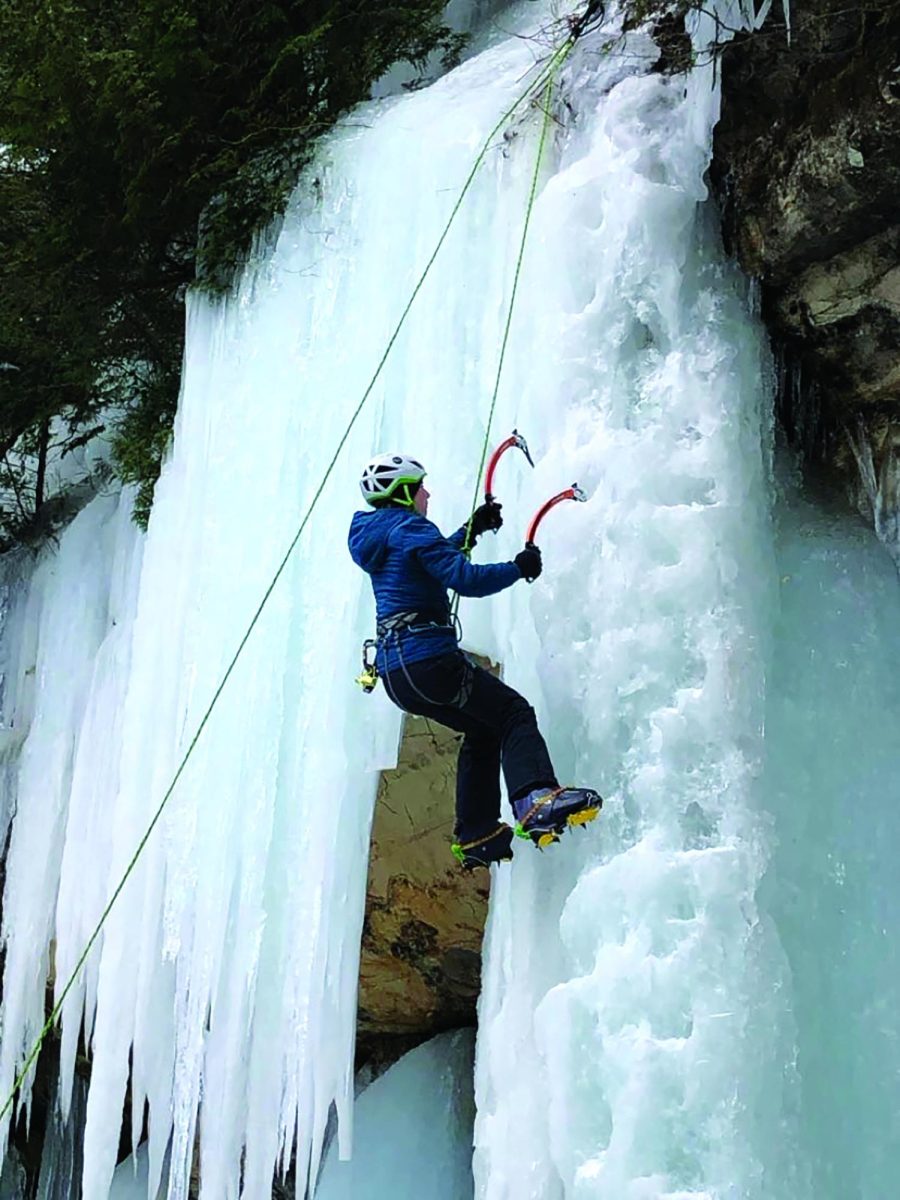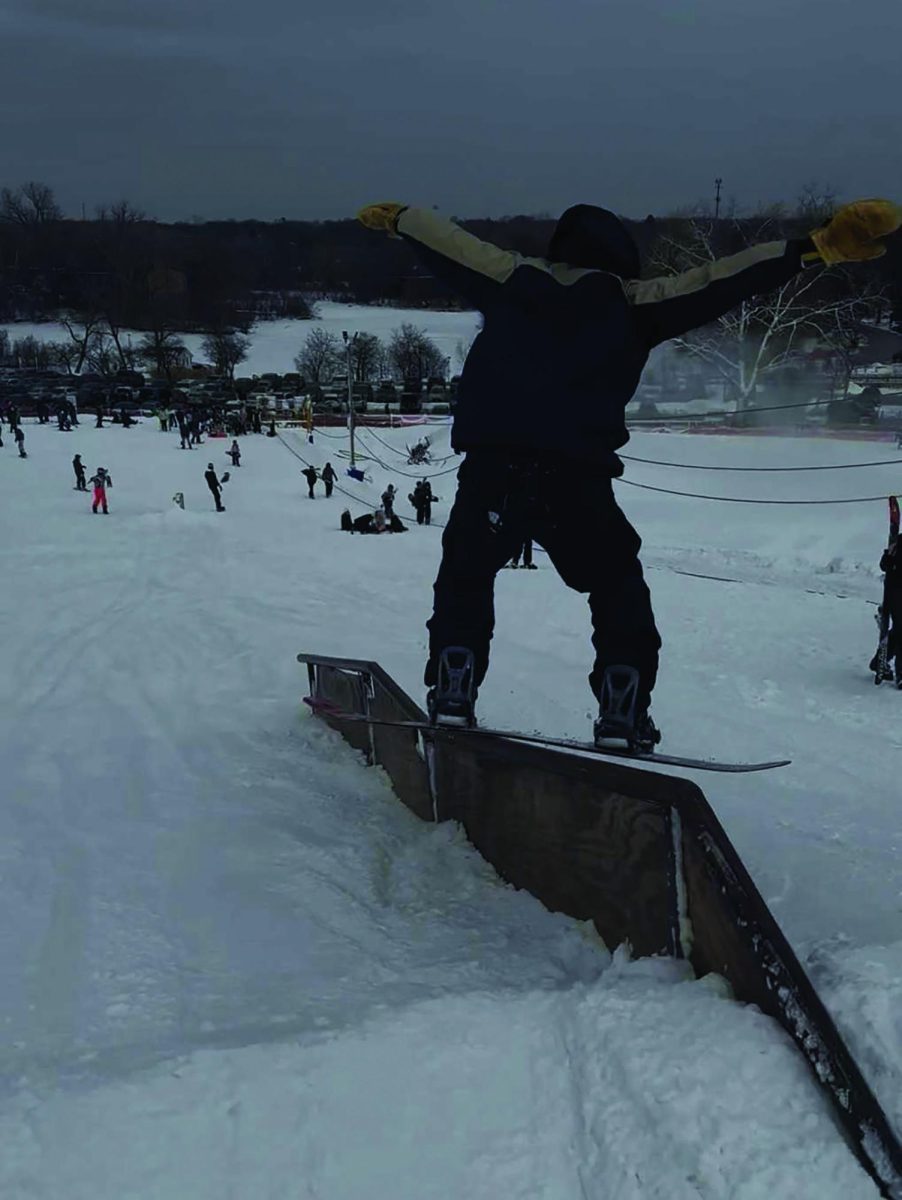As most of us have lived amongst the ever-changing temperamental climate unique to the Upper Midwest our entire lives, we are all too familiar with the bitter cold found in the winters. And for many of us, that cold is a burden. We hibernate, running inside and staying safe in the comfort of a heated home. Most activities take place indoors as well, and some sports have a designated indoor season.
However, some of us choose to embrace the cold. A few LT students have found ways to stay active and entertained, in activities that require colder temperatures. They are of the minority, but all the while it makes them more inspiring to achieve.
Strike a ‘Froze’
Veronika Azevedo ‘24 has been involved in competitive figure skating for many years, but was first introduced to the craft at four years old when her grandpa took her to a public skate.
“I really enjoyed it, so my mom put me in group classes, and it kind of snowballed from there,” she said. “I started doing private lessons too, and by the time I was ten I was like, ‘this is what I want to do.’”
Competitive figure skating is split into eight separate levels, each of which a skater needs to pass before moving to the next levels. The highest level is senior, which is what is typically seen in national competitions and the Olympics. The top five levels have national qualifying competitions, where skaters travel around the country in attempts to put up the best score. For the top two, junior and senior, there are overall national competitions, and for the three levels below, competitors are put onto a national development team.
“This year I competed at Novice which was the third from the top level, but I got injured in the middle of the season so I wasn’t able to compete in most of my qualifying competitions,” Azevedo said. “Next year, I plan on competing as a senior, so I’ll test up through that level, and I’ll complete qualifying senior. I plan to compete as a collegiate senior too, so I’ll qualify for a lot of scholarships.”
Figure skaters train with a combination of on ice and off ice practices, she said. Similar to the way swimmers participate in dry-land drills, figure skaters practice their turns on spin-boards also used for dance. Figure skating is also a high-injury risk activity, especially since they land their turns with five to eight times their body weight, and most of the impact is absorbed in the joints. To help avoid injury, the skaters will also do weight-lifting exercises to make their bodies as strong as possible.
“I’m very injury prone so I have a lot of problems with my shins, knees and ankles,” she said. “It’s hard knowing how much I can do at practice to where I’m not going to break myself, but still doing enough so I’m still advancing and pushing myself.”
Azevedo is also coaching figure skating to younger kids now, passing on her level of knowledge to the next generation.
“It’s fun to see the kids gain that same spark and want to continue it,” she said. “It’s also cool to be a role model because you can tell they look up to you.”
Figure skating also gives medals to those who test successfully through all eight levels. Azevedo has received her gold medal in the category named “edgework,” and is currently working towards medaling in ice dance. She only has six more dances to complete in front of a panel of judges before being awarded.
“[Skating] just clears my mind,” she said. “You have to be very in tune with what you’re doing, so there’s not a lot of space for thinking. There’s such an athletic aspect to it, especially being on ice, and it’s so different from anything else.”
Dashing through the Snow
After beginning to snowboard 11 years ago, Ryan Murphy ‘24 is 100% onboard to keep up with the sport in the future.
“To me, when some asks if I would like to go snowboarding, it means would I like to grab a group of great friends drive two hours, screw around for a while, get all stoked on each other, then drive home sore and in silence–with the exception of a good aux,” he said. “I love every part.”
Murphy snowboards in various locations nearby, such as Alpine Valley, which is about two hours away; Four Lakes, which is 30 minutes from campus; Wilmot Mountain, which is around an hour and a half away; and Devils Head, the farthest of the four at three hours away.
“[I try to go] whenever I can,” he said. “[It] usually ends up being every other weekend, give or take a couple weekends. Once a year, me and a couple friends take a trip to Breckenridge, Colorado.”
Skiing in Colorado dwarfs the experiences in Illinois, Murphy said. The real mountains, shocking heights, and the guarantee of more snow create much more mesmerizing conditions for both snowboarding and skiing. Also, the views of the Colorado wilderness are enough to leave any person awestruck.
“The first time I went to Colorado was magic and the feeling of being on an actual mountain is amazing,” he said. “One of my favorite snowboarding memories from this trip was skiing North America’s highest lift in a white out – which is not ideal conditions. It was more fun when I could actually see more than a foot away from me, but it was definitely an experience. I also did a tamedog, a cartwheel front flip type of thing there, which surprised me because I didn’t think I would be able to. I haven’t done one since unfortunately.”
Although snowboarding can be a fun activity in the winter time, it is not for the faint of heart. It has a high risk for injury, and Murphy once cracked his head open on the slopes.
“I don’t remember doing that, but I also don’t remember anything until I woke up the next morning so I guess that makes sense,” he said. “I’m told it was pretty gnarly.”
Aside from the exhilarating nature of the sport, it’s also a great way to build friendships, Murphy said. Zach Thornton ‘23 is among Murphy’s snowboarding friends and they’ve both worked on mastering the skill.
“I like snowboarding because every time you go you get better,” he said. “You can also really test yourself and your abilities both on your board or skis, but also your ability to overcome fear. As a bonus, I think it’s also one of the most enjoyable things you can do in your life.”
Ice, Ice, Baby
Ice climbing, a lesser known form of climbing with many parallels to rock climbing, is a unique experience that isn’t very common in the United States. However, for Poppy Graber ‘24, it has been with her and her family since sixth grade.
“My dad had been going to this thing called the Michigan Ice Fest for a long time and there was a scholarship available for me to go and climb with other girls around my age,” she said. “Sixth grade was the first year that I applied for it, and I was able to get the scholarship two years in a row. I’ve just been doing it every year ever since.”
Graber won the Sue Nott scholarship, which awards between seven and ten girls the opportunity to go ice climbing at Michigan Ice Fest in honor of the late ice climber. The scholarship is available to girls from ages 7-19, and offers an introductory course into ice climbing to promote and inspire women to ice climb. In order to ice climb, special supplies are necessary, called ice tools.
“You’ll need crampons, which are things that you attach to your boots and they have spikes on the tip of the toes so that you can kick into the ice,” Graber said. “[You also need] ice axes that are curved and have a sharp tip in order to grip the frozen waterfall.”
The Michigan Ice Fest is located in the Upper Peninsula of Michigan and takes place in February. Graber and her family will also go to Starved Rock to climb, but Michigan Ice Fest is her overall favorite experience. The waterfalls she typically climbs range from 25-30 feet, the tallest being 50 feet.
“Every year, waterfalls freeze differently,” she said. “Even if you go the same route, you are still climbing a different shape, and you are met with challenges and are able to push yourself.”
Graber hopes to continue climbing in college, but it’s difficult because of the uniqueness of the sport, and the need for ice.
“I will definitely want to continue if I can,” she said. “This is definitely a unique experience, and a lot of people don’t know about it, so I love to share about it and have people learn. Ice climbing is a challenge and a new endeavor that I enjoy doing and trying new routes and it allows me to push myself and challenge myself.”





















![Movie poster for '[Rec]" (2007).](https://www.lionnewspaper.com/wp-content/uploads/2023/04/rec-640x900.jpg)







